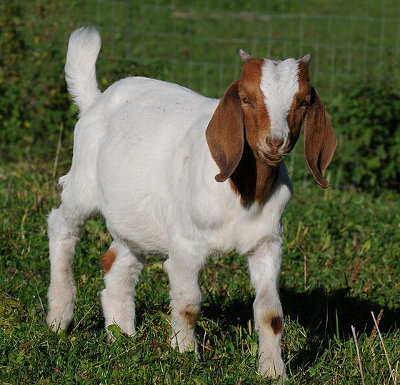Boer Goat
Category: Goat

Facts about Boer Goat, The "Boer Goat" is a variety of goat that was urbanized in South Africa during the early 1900s for the production of meat, which is one of the most popular for their meat and not for their milk. Their name is originated from the word Boer, the Afrikaans word, which means farmer of Dutch descent. The Boer goat breed was most likely bred from the South African native. "Scientific name for Boer Goat is Capra aegagrus hircus".
goats, by the Fooku and the Namaqua Bushmen tribes, with some crossing of European and Indian bloodlines being achievable. These goats were chosen for meat instead of milk production. The Boer Goat has a speedy growth rate and outstanding carcass qualities, owing to selective breeding and improvement and making it one among the world’s most admired breeds of meat goat. The Boer Goat has a high confrontation to disease and acclimatizes well to hot, arid semi deserts.
Features of Boer Goat
Generally, the Boer Goat has a white color body and a distinctive brown color head. Some goats of this variety can have a totally white or brown color body. These goats have extended, pendulous ears, and they are renowned for being passive, fast-developing, and having lofty fertility rates. Does, which are the female Boer goats have greater mothering abilities when compared to other goat breeds. A mature Boer buck, that is a male Boer Goat usually has a body weight between 240 lbs and 300 lbs (110 kg and 135 kg, whereas a female Boer Goat usually has a body weight ranging from 200 lbs to 220 lbs (90 kg to 100 kg).
A high-class buck can create high-class offspring even when mated with a normal Doe. These goats are inclined to put on weight at about the equal rate as their sire, so a male goat from an established fast-developing bloodline will grasp the maximum price because its offspring will also be inclined to be the fast developers. The key market for butcher goats is a 50 to 80 lb (22 to 36 kg) youngster, and the offspring will attain a sale-able size at the weaning age. The youngster of an established fast-breeding sire will have a body weight of 80 lbs (36 kg) at 90 days, whereas the youngster of a poor-quality sire will have only a body weight of 35 lbs (15 kg) at 90 days.
Normally, the female Boer goats will breed extremely large show-quality goats because show goats are predictable to be of huge physique. For the production of commercial meat production, normally, the average-sized nannies are preferred because they produce the equal amount of kids, but they need less nourish to achieve so. As a universal rule, the more offspring born per doe, the better profit margins for the possessor. Boer goats can breed all through the year, and they attain sexual maturity when they reach the age of five months. A typical female Bore Goat is capable of producing three youngster crops once in two years, which means that the female goats are with child for five months, look after their offspring for three months and after that, are rebred. Even though Boer goats are raised purposely for show reasons, they may appear to have slight in common with pastured marketable goats, the only difference is the exterior.
The average lifespan of the Boer Goat ranges from 8 years to 12 years. The scientific name for goat (Capra aegagrus hircus) was derived from the Wild Goat (C. aegagrus). In latin "Capra" is the root of the word "capricious" which means whimsical, mischievous, quirky, bizarre and suitable to change fast. Mother Boer goats will call their young so they stay close at all times, a baby goat is called a "kid". The Mother and kid goat recognize each others calls as soon as the mother gives birth. Baby Boer goats are weaned off their moms after around 6 months. Its called "bleating" how goats communicate with each other. A "doe" or "nanny" is what a female goat is called. A "buck or "billy" is what they call a male goat. A male castrated goat is called a "wether". "Kidding" is the act of a goat giving birth.
Boer goats can even climb trees because they have great balance and some goat species can jump over 5 feet high. A Boer goats eyes are rectangular rather than round. At night they have excellent vision and can due just as much at night. A goat herder notice how much energy his goats had, after eating coffee bushes and that's how coffee was first discovered. There are over 210 breeds of goats in the world. Boer goats have no teeth in their upper front jaw. Boer goats have 24 molars and 8 incisors. Both sexes, female and male goats can have beards. Male Boer goats reach puberty at the age between 4 to 8 months and the female is between 7 to 10 months. Male Boer goats at the beginning of mating season go through a period called a "rut". The "rut" is the beginning of the courting for a doe, a very strong foul musky odor and fighting between bucks begins. Goats can be born without or with horns "polled". Boer goats have a four chamber stomach, goats are "Ruminant" is any hoofed even-toed mammal, that digests its food in two stages. First by eating the raw materials and regurgitating a semi-digested form known as "cud" (ruminating: chewing the cud.) then eating the cud. The goat is one of the 12 animals in the Chinese zodiac. "Wattles" is that little tufts of hair that dangles from the goats throat. A Boer goat is a herbivores, that eats leaves, grass, hay and furns {plant eaters}.

 Back To Category Goat
Back To Category Goat